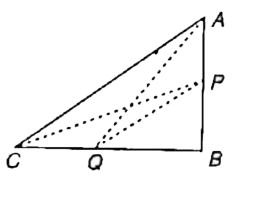In ΔABC,∠Band∠C are acute angles. BE and CF are perpendicular from vertices B and C on sides AC and AB respectively. Then BC2 is equal to-
AB×BF+AC×CE
AB×BF+AB×CE
AC×BF+AB×BF
BF×CE+AB×AC
To solve the problem, we need to find the expression for BC2 in triangle ABC where BE and CF are the perpendiculars from vertices B and C onto sides AC and AB respectively.
1. Identify the triangles: We have triangle ABC with acute angles B and C. The points E and F are the feet of the perpendiculars from B to AC and from C to AB respectively.
2. Apply the Pythagorean theorem in triangle ABE:
AB2=AE2+BE2
Here, AE=AC−CE, so we can express AE as:
AE=AC−CE
Therefore, substituting AE:
AB2=(AC−CE)2+BE2
3. Expand the equation:
AB2=(AC2−2AC⋅CE+CE2)+BE2
This simplifies to:
AB2=AC2+CE2+BE2−2AC⋅CE
4. Apply the Pythagorean theorem in triangle ACF:
AC2=AF2+CF2
Here, AF=AB−BF, so:
AC2=(AB−BF)2+CF2
5. Expand this equation:
AC2=(AB2−2AB⋅BF+BF2)+CF2
This simplifies to:
AC2=AB2+BF2+CF2−2AB⋅BF
6. Apply the Pythagorean theorem in triangle BCF:
BC2=BF2+CF2
7. Combine the equations: We now have expressions for AB2 and AC2 that include BF2 and CF2. We can add these equations together:
AB2+AC2=(AC2+CE2+BE2−2AC⋅CE)+(AB2+BF2+CF2−2AB⋅BF)
8. Rearranging the terms: After adding, we can isolate BC2:
2BC2=AB2+AC2−2AB⋅BF−2AC⋅CE
Dividing by 2 gives:
BC2=12(AB⋅BF+AC⋅CE)
Final Result:
Thus, we conclude that:
BC2=AB⋅BF+AC⋅CE
AB2=AE2+BE2
Here, AE=AC−CE, so we can express AE as:
AE=AC−CE
Therefore, substituting AE:
AB2=(AC−CE)2+BE2
AB2=(AC2−2AC⋅CE+CE2)+BE2
This simplifies to:
AB2=AC2+CE2+BE2−2AC⋅CE
AC2=AF2+CF2
Here, AF=AB−BF, so:
AC2=(AB−BF)2+CF2
AC2=(AB2−2AB⋅BF+BF2)+CF2
This simplifies to:
AC2=AB2+BF2+CF2−2AB⋅BF
BC2=BF2+CF2
AB2+AC2=(AC2+CE2+BE2−2AC⋅CE)+(AB2+BF2+CF2−2AB⋅BF)
2BC2=AB2+AC2−2AB⋅BF−2AC⋅CE
Dividing by 2 gives:
BC2=12(AB⋅BF+AC⋅CE)
Thus, we conclude that:
BC2=AB⋅BF+AC⋅CE
Topper's Solved these Questions
Similar Questions
Knowledge Check
In ΔABC,∠C=∠A,BC=4cmandAC=5cm. Then, AB = ?
A4 cmB5 cmC5 cmD2.5 cmIn right angled ΔABC,∠B=90∘, if P and Q are points on the sides AB and BC respectively, then :
 AAQ2+CP2=2(AC2+PQ2)BAQ2+CP2=AC2+PQ2C(AQ2+CP2)=12(AC2+PQ2)D(AQ+CP)=12(AC+PQ)
AAQ2+CP2=2(AC2+PQ2)BAQ2+CP2=AC2+PQ2C(AQ2+CP2)=12(AC2+PQ2)D(AQ+CP)=12(AC+PQ)
In a ΔABC,∠C=3∠B=2(∠A+∠B) find the three angles.
View SolutionIn ΔABC,∠A is acute. BD and CE are perpendicular on AC and AB respectively. Prove that AB×AE=AC×AD.
View SolutionIf ΔABC is an isosceles triangle with AB = AC. Prove that the perpendiculars from the vertices B and C to their opposite sides are equal.
View SolutionConsider ΔABC of sides 3,5 and 6. Altitudes AD, BE and CF drawn from vertices A, B and C on sides BC, CA and AB respectively are concurrent at H. If (HB)(HC)(BC)Area(ΔHBC)=m√n where m and n are coprime, then (m+n) equals
View SolutionIn ΔABC,
∠C=90∘,
∠B=60∘,
∠C=6. Find AB.
View SolutionIn ΔABC, C is right angle and a perpendicular 'p' is drawn on side AB. If a, b, c are length of sides BC, CA, AB respectively then which of the following is correct?
View Solution
